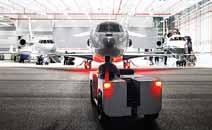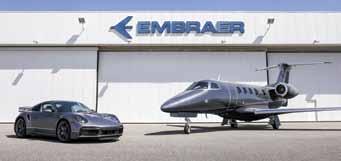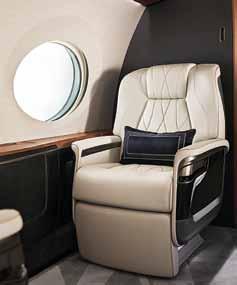
23 minute read
NEWS AT A GLANCE
Gulfstream Boosts SAF on the Sidelines of BizAV Sustainability Summit
By Ayushee ChAudhAry
Advertisement
Gulfstream aerospace corporation an-
nounced the extension of its contract with World Fuel Services to continue providing the business-jet manufacturer with a steady supply of Sustainable Aviation Fuel (SAF) produced by World Energy.
Gulfstream President Mark Burns announced the deal in September during the Virtual 2020 Business Aviation Sustainability Summit to discuss pathways to accelerate the market for SAF. Business Aviation leaders convened for a first-of-its-kind Virtual 2020 Business Aviation Sustainability Summit in September to discuss further ways to accelerate the sustainable aviation fuels market,
NetJets, VistaJet and Signature Flight Support also announced purchase agreements with SAF suppliers in September
the cleaner-burning alternative fuel that often reduces net lifecycle carbon dioxide (CO2) emissions in excess of 50 per cent, versus conventional jet fuel (on a gallon-per-gallon basis). Experts along every point on the value chain – manufacturers, producers, providers/ FBOs, operators, and government leaders discussed and determined how to increase the production, availability and use of SAFs.
This contract extends Gulfstream’s original multiyear purchase agreement, which was the first of its kind in business aviation when it was signed in 2015. Since March 2016, Gulfstream has used SAF for its Savannah-based fleet, which comprises corporate, demonstration, completion, customer support and flight test aircraft. The com-
Gulfstream extends ContraCt for low Carbon sustainable aviation fuel
pany has made more than 650 flights with an SAF-JET A fuel blend, SAF suppliers last month. These companies were NetJets, VistaJet flying more than 1.3 million nautical miles and reducing carbon diox- and Signature Flight Support. VistaJet announced to secure availide emissions by approximately 1,700 metric tonnes. ability for its customers globally of SAF sourced and delivered by
“This renewal marks another step in our ongoing commitment to SkyNRG. The fuel for VistaJet, like Gulfstream, will be produced by promoting positive change in our industry. Reducing our impact on World Energy. While Signature and NetJets will receive their supply the environment by using SAF is a move we all should consider mak- of SAF from Nestet San Francisco and London Luton airports. The ing. Creating a sustainable future for aviation is a responsibility we Finnish renewable fuel producer has also just signed a SAF supply share, and we appreciate the leadership, innovation and collaboration agreement with Shell Aviation. of World Energy in helping Gulfstream — and the industry at large The forum was hosted by the Business Aviation Coalition for Sus— fulfill that responsibility,” said Mark Burns, President, Gulfstream. tainable Aviation Fuel (SAF Coalition), which just released Fueling
Gulfstream claims that its sustainability strategy helps support the Future, an educational and informational guide about SAF develindustry goals established by the National Business Aviation Asso- opment, industry adoption and expansion of supply and use. The ciation (NBAA), the General Aviation Manufacturers Association guide has given out initiatives to educate industry leaders, policy(GAMA) and the International Business Aviation Council (IBAC). makers and others on the benefits and viability of SAF in conjunction The goals include: with the World Economic Forum and previous events held at airports l 50 per cent reduction in CO2 emissions by 2050 relative to 2005 in Van Nuys, Farnborough, United Kingdom (UK), Geneva and Las levels; Vegas. The guide also details on how indusl Two per cent improvement in fuel- try leaders can incorporate SAF into their efficiency per year from 2010 to 2020; operations and accelerate the adoption of l Carbon-neutral growth from 2020 low-carbon fuels, while reducing greenonward. house gas (GHG) emissions.
The renewable fuel used by Gulfstream Industry innovators further plan to prois produced by World Energy at its refinery in Paramount, California, from a feedstock of agricultural waste, fats and oils. Fuel and “This renewal marks anoTher sTep in our duce SAF blending components with deeper reductions, and in some cases more than 100 per cent, making the fuels carbon negative. aviation services provider World Fuel Services manages the logistics, including distribution of SAF to Gulfstream on both U.S. ongoing commiTmenT To promoTing posiTive SAF is a proven and trusted replacement for traditional jet fuel that will help lower the industry’s carbon footprint. SAF has been coasts. In addition to using the 30/70 blend change in our used continuously at select airports since of low-carbon, drop-in SAF at its Savannah headquarters, Gulfstream makes it availindusTry. reducing 2016, and its production is expected to scale significantly during the next five years. able for customers at its Van Nuys and Long our impacT on The The guide suggests that the single-largBeach, California, service centers. SAF is the only fuel on-site at Gulfstream Long Beach, which also uses it for completions and delivenvironmenT by using saF is a move we all est potential reduction in aviation’s GHG emissions — and the key to reaching our goals — will come about through the broad ery flights. “The innovative partnership between Gulfstream and World Energy paved the should consider making,” said mark adoption of sustainable aviation fuel in place of the current conventional jet fuel. The guide further builds upon a host of iniway for a larger sustainability movement,” burns, presidenT, tiatives on the benefits and viability of SAF. Burns said. “For almost a decade, we have leveraged our collaboration with World gulFsTream. “This new edition of the guide reinforces our global commitment to sustainable aviaEnergy to increase awareness and availabil- tion fuels, and provides a fresh resource to ity of SAF around the world. We look for- further educate the business aviation indusward to continuing that work.” try of this drop-in alternative jet fuel. SAF
In 2019, the company launched a service that allows operators to represents a critical measure to help the global industry meet its longpay a usage-based annual fee towards activities that generate an equal term goal to address climate change by halving carbon emissions by reduction in carbon emissions, helping them to offset the carbon foot- 2050 relative to 2005 levels,” said IBAC Director General Kurt Edwards. print of their flights. The offsets fund certified and verified projects The guide is developed by the SAF Coalition which includes the covering wind energy, forest management, farm power and the recov- Commercial Aviation Alternative Fuels Initiative, the European ery and utilisation of landfill gas. Business Aviation Association, the General Aviation Manufactur-
Last year around the same time Gulfstream had also announced ers Association, the International Business Aviation Council, the that the Gulfstream G650ER, Gulfstream G600, Gulfstream G500, National Air Transportation Association and the National Business Gulfstream G550 and Gulfstream G280 made the company’s first car- Aviation Association. bon-neutral flights, traveling from Savannah to the Las Vegas area for “We are thrilled to present this second edition of the SAF Guide. the 2019 National Business Aviation Association Convention & Exhi- The coalition’s goal has always been to increase the production and bition (NBAA-BACE). The five flights were made using a combination use of SAF, and education through this guide is key to that mission. of sustainable aviation fuel (SAF) and carbon offsets. Many thanks to all those who put in a tremendous effort to make rel-
Coinciding with the Summit, three more organisations from the evant updates and information available to the public,” said NATA sector, other than Gulfstream announced purchase agreements with President and CEO Timothy Obitts. BAI
Gulfstream G500 and G600 Again Exceed Expectations
Gulfstream Aerospace announced the next-generation Gulfstream G500 and Gulfstream G600 have once again demonstrated additional range capabilities through real-time operations.
The newly increased range for the G500 and G600 apply to both the high-speed cruise of Mach 0.90 and the long-range cruise speed of Mach 0.85. The G500 now delivers 5,300 nautical miles/9,816 kilometers at Mach 0.85 and 4,500 nm/8,334 km at Mach 0.90. The G600’s range at Mach 0.85 has improved to 6,600 nm/12,223 km and 5,600 nm/10,371 km at Mach 0.90.
“The G500 and G600 have been exceeding expectations since they entered service,” said Mark Burns, President, Gulfstream. “This latest demonstrated range increase provides further proof of the tremendous efficiency and versatility of these aircraft. The Gulfstream team is always looking for opportunities to improve aircraft capabilities and the customer experience, and we are pleased to deliver another performance enhancement for both existing and future customers.”
In addition to the range increases, the G600 now delivers greater payload capacity with full fuel. As a result of Gulfstream’s advanced manufacturing and precision-build expertise, the G600’s basic operating weight has been reduced by 570 pounds/259 kilograms over original values, bringing its full-fuel payload capabilities up to 2,600 lbs/1,179 kg. This gives G600 operators even more flexibility.
During the flight-test programme for the G500 and G600, both aircraft exceeded initial performance expectations with increased range capabilities. The G600 achieved a second high-speed cruise range increase before it entered service, gaining 700 nm/1,296 km over original projections. The maximum operating speed of both aircraft is Mach 0.925. BAI neering, performance, and design, Embraer and Porsche will produce just ten pairs of business jets and sports cars, providing a truly seamless experience from road to sky, for the first time in history.
Duet brings the Phenom 300E and the 911 Turbo S into perfect harmony. As the world’s fastest and longest-ranged single-pilot business jet, the Phenom 300 series transformed the light jet category. From its revolutionary, award-winning interior design, with an abundance of cabin and baggage space to its highly intuitive avionics, this well-rounded machine delivers unmatched performance, exceptional comfort, and class-leading technology, at envi-
Dassault’s 500th FalconCare Maintenance Contract
Dassault Aviation recently signed its 500th contract for its FalconCare guaranteed maintenance programme and further expanded the programme — already the most comprehensive in the industry — to meet a broader range of customer needs and budgets. Introduced in 2005, FalconCare offers a full range of scheduled and unscheduled maintenance services through C-Check, including airframe, avionics and landing gear parts, labour, consumables, service bulletins and maintenance tracking. This comprehensive coverage ensures predictable and stable annual maintenance costs for operators of Falcon aircraft. It provides maintenance coverage everywhere on the planet through more than 60 Dassault Owned and Authorised Service Centers and 16 Falcon Spares distribution centers.
The new programme expansion, based on feedback from flight departments and the Falcon Operator Advisory Board, enhances the flexibility of the pay-as-you-go Falcon Care service plan by offering operators two different levels of coverage, in accordance with their actual maintenance requirements. Each plan includes a FalconCare Efficiency Bonus, which financially rewards operators engaging in the most cost-effective maintenance practices. And both allow operators to establish a Flex Spending Account for miscellaneous costs

Embraer and Porsche to Deliver Limited Edition “Duet”
Embraer and Porsche have collaborated to create ‘Duet’, a limitededition, limited-quantity Embraer Phenom 300E aircraft and Porsche 911 Turbo S car pairing. Both known for world-class engi-
outside FalconCare coverage. BAI ably low operating costs, with features previously available only on Turbo S resulting in a uniquely designed jet and car, both featuring much larger jets. The 911 is the heart of the Porsche product portfo- a customised interior and paint scheme inspired by one another. To lio and has one of the longest and most celebrated traditions in the mark this first ever collaboration between Embraer, Porsche AG, automotive industry. The 911 Turbo S is the peak of the 911 models and Porsche Design, Duet customers will also receive a custom Duet and stands for both performance and usability. logo luggage set with a pilot’s bag and two weekenders, as well as a
Designed in tandem, Duet fuses speed and style, luxury and special edition Porsche Design 1919 Globe timer UTC titanium-case power — signatures of both the Phenom 300E and Porsche 911 watch inspired by the aircraft’s cockpit. BAI

Gulfstream G700 Recognised for Design Excellence
Gulfstream Aerospace Corporation announced the Gulfstream G700 earned a 2020 International Yacht & Aviation Award for the industry flagship’s all-new seat design. The Gulfstream G500 and Gulfstream G600 received the same accolade in 2018.
“I am proud of the Gulfstream team that worked diligently to build on our excellence in cabin comfort,” said Mark Burns, President, Gulfstream. “Behind this award is a team of the industry’s most talented engineers, designers and craftspeople, who combined innovation and artistry to create a seat that is both comfortable and beautiful. It’s a perfect complement to the Gulfstream Cabin Experience that enhances wellness and increases productivity.”
The G700 Classic Seat features a timeless wingback silhouette updated with intricate details and curves that reflect the overall G700 cabin design and architecture. The Classic Seat was designed for increased customisation with side and back paneling that customers can choose to accent with veneer, paint, leather or textiles. Customers collaborate with Gulfstream designers and artisans to choose their materials and explore the multitude of design possibilities available through stitching, piping and other personalisation. To create the award-winning seats, Gulfstream’s research and development team started with a clean-sheet design that they matured through meticulous modeling and extensive comfort studies, resulting in organic, anatomical shaping that enhances comfort for all body types. Artisans at Gulfstream’s seat shop bring the designs to life with customised bolstering, trimming and hand-stitching, ensuring the durability, beauty and comfort of the G700 Classic Seat. Introduced in October 2019 as the business-jet industry’s new flagship, the G700 features the most spacious cabin and can fly farther and faster than any other business aircraft. The G700 can be configured for up to five living areas and includes the industry’s only ultra galley with passenger lounge or crew rest; a six-place dining or conference area; and a grand suite. The Gulfstream Cabin Experience on the G700 comprises 20 panoramic windows, 100% fresh, never re-circulated air, the lowest cabin altitude and ultra quiet noise levels. BAI

The Opportunity to Rethink... continued from page 7
l
l
l Promotions by local State Governments: State Governments have their own internal need for private aircraft (fixed wing or helicopter) travel and many have a dedicated civil aviation department. The civil aviation department can build small FBOs at airports where there is significant State and private aircraft travel. A saying goes “Build and they will come”. Once State officials, business persons experience the ease of rapid checking through an FBO, they will prefer it over commercial terminal any day. Acceptance of professional aircraft management companies: Establishing an aviation company with non-scheduled operating permit (NSOP) is a cumbersome process of potential business aircraft operators and owners. If DGCA could allow import of aircraft by owners and outsource operations to professional aircraft management companies that would significantly reduce their workload. The agency would only have to audit few aircraft management companies as opposed to several individual aircraft operators. Acceptance of fractional ownership model in India: Several businesses want to own aircraft but can’t afford the high price tag for the amount of their usage. However, they would be highly encouraged if they had an option to own part of the aircraft and avail depreciation benefits for their share of the aircraft. Fractional ownership is a highly successful model in the west and if
allowed, it would open up a new market of aircraft ownership in India. The subsequent effect on the increase in shared fleet would have a domino effect on the economy. l Stricter regulatory oversight, but easier entry: For new operators, the process of getting a non-scheduled operator permit (NSOP) could be as long as nine months to a year. Of this up to six are taken for security clearance. This discourages a lot of potential entrants. Ideally, this time should be reduced to a maximum of six months. l e-Governance of DGCA: Off late, DGCA has started the process of digitising several processes, which earlier involved several visits to their offices. The digitisation needs to be further fast tracked in several such processes or clearances which lead to wastage of undue man hours.
As our Prime Minister mentions, we have to change COVID-19 adversity into opportunity. It is the right time for the Government to make changes. The Ministry and the supporting aviation agencies have the right team, skills and wherewithal to carry out large changes and the Government has the right attitude to implement changes. In a growing civil aviation sector, a significant change in the business aviation industry will provide a much needed fillip and motivation, required for the growth of this industry. BAI
we at sp guide publications (founded way back in 1964 by shri s.p. baranwal, founder publisher and founder editor) are proud to state
First time, SP Guide Publications participated in nomination process for aerospace media awardes in 2019 AND, sp guide publications emerged as a winning media with seven articles nominated as finalists under 4 categories whereas, aviation week & space technology group had their five articles nominated as finalists whereas, flightglobal group had their five articles nominated as finalists whereas, ihs jane’s group had their two articles nominated as finalists
and indeed, sp guide publications is further proud to state that it received the award: aerospace media awards - asia 2020 under best propulsion submission for the article “engine leasing” published in SP’S AVIATION 8/2019
` 100.00 (Ind I a-based buyer only)
SP’s an sP GuIde PublIcatIon
aviation
S h a r p C o n t e n t f o r
www.sps-aviation.com a S h a r p a u d i e n C e
vol 22 ISSUE 8 • 2019
RNI NUMBER: DELENG/2008/24199
military
• india inducts 8 apache gunships • france strongly pitches 36 additional rafale
laSt WOrD: CHaNDrayaaN 2 failures are pilLArs of success 50 years of embraer 50 50YEARS OF PAgE 5
APOLLO 11
Civil
Leasing
EnginE LEasing
Aircraft spare engine leasing is separate from aircraft leasing because engines require more intensive technical management
By Group Captain a.K. SaChdev (retd)
Shannon EnginE Support LimitEd SpEciaLiSES in providing SparE EnginE LEaSE SoLutionS to cFm56 and LEap opEratorS around thE gLobE
photograph: www.SES.iE
in general, the airline industry is capital intensive
and the aircraft used by it are high cost and long life assets. Moreover, how these aircraft come to be flying with a particular airline is not always the result of a simple purchase form the aircraft Original Equipment Manufacturer (OEM). The most common modus operandi is a sale and leaseback wherein a tripartite agreement between the airline that originally booked an aircraft with the OEM lets a leasing company buy it from the OEM and then the airline leases it from the leasing company. Payments to OEMs include options (amounts paid in advance to book an aircraft purchase), purchase rights, deposits and progress payments. While aircraft leases have been in vogue ever since airlines started sprouting up, engine leasing market started emerging only around three decades ago. At first glance, leasing of an engine differentiated from purchase or lease of an aircraft of which it is a part, appears befuddling, but there are financial reasons for this to happen which have evolved from experience over decades of commercial operations.
ENGINE LEASING
It is customary for a car or a load carrying vehicle to be designed to carry a single (the same) engine for its entire life; in contrast, an aircraft engine is a replaceable part of the aircraft which gets replaced several times during an airframe’s useful life, depending on aircraft type, utilisation rate, company policies, regulatory mandates and occasionally due to accidents/incidents. As aircraft down time is expensive in terms of lost revenue, airlines generally maintain a number of spare engines to ensure aircraft are not grounded when engines are removed for normal maintenance or as a result of failure. Prior to development of the aircraft spare engine leasing business, airlines had to manage engine removals via spare engine ownership or expensive emergency engine leasing. Aero engine leasing is not as old as aircraft leasing and not long ago operators owned their engines including the spare ones they needed. However, as engines became more powerful and more technically advanced, their costs also skyrocketed; in addition to initial costs, their maintenance costs also increased considerably. Engine leasing became attractive for the same reasons as aircraft leasing in a capital intensive, cost conscious resource milieu. When an aircraft is acquired by an operator, it would normally establish an engine life cycle management plan so as to maximise on wing time and reduce workshop time to the minimum. This plan aims at finding a middle ground between airworthiness perspectives and cost saving considerations over engine life cycle.
Aircraft spare engine leasing is separate from aircraft leasing because engines require more intensive technical management. Since engine overhauls are one of the largest airline operating cost segments, each overhaul must be closely managed. Engine lessors work with airline customers to optimise the cost and ready availability of spare engines at short notice. Pratt & Whitney (P&W), a leading engine OEM has its engines mounted
26 ISSUE 8 • 2019

www.sps-aviation.com Civil
Leasing
on more than 130 different aircraft types including regional air- aircraft from either another operator or a financial institution liners, business jets, general aviation aircraft and helicopters. (the lessor). India has ratified the 1997 Article 83bis of the ConTo support this vast market and related Maintenance Repair & vention on International Civil Aviation 1944 which was the first Overhaul (MRO) activities, P&W claims that it offers the largest substantial amendment of the Convention and came about in engine rental and exchange pool of any engine OEM in the form response to industry growth and leasing trends. Under Article of more than 850 engines worldwide to support its MRO activi- 83 bis, a bilateral agreement can be signed between the aviaties. The other leading engine OEM is CFM International, a 50/50 tion authorities of two contracting states and that agreement joint company formed in 1974 by Snecma (Safran) in France and transfers and delegates the responsibility for the regulation and GE in the US. Shannon Engine Support Limited (SES), a wholly- safety oversight of an aircraft in accordance with the requireowned subsidiary of CFM International, specialises in provid- ments of the state of registration from that state to the air transing spare engine lease solutions to CFM56 and LEAP operators port authorities in the airline’s home state. DGCA meticulously around the globe. Headquartered in Shannon, Ireland, with maintains a register of aircraft with details of aircraft type,, year marketing offices in Beijing and Budapest, SES has a portfolio of of manufacture, full name and address of the owner or lessor over 200 CFM56 and LEAP spare engines, including CFM56-5B, and of the operator or lessee. The notable point is that there is CFM56-7B, LEAP-1A and LEAP-1B engines. SES’ 13 strategic no engine-specific register in India to record separate registrapool locations give SES both the capacity and the reach to sup- tion title of an engine on an aircraft, whether maintained by port airlines operating CFM engines worldwide. The Rolls-Royce DGCA or any other registry. The certificate of registration for the & Partners Finance companies (collectively, the “RRPF Affili- aircraft does not include details of the engine(s) mounted on it. ates”) are a collection of 50 per cent owned domestic and foreign joint ventures with Rolls-Royce, another leading manufacturer of CONCLUDING REMARKS commercial aircraft jet engines. The RRPF affiliates are primar- Aircraft engine leasing is a highly effective and economical alterily engaged in two business activities: lease financing of aircraft native even for large operators who own the majority of their spare engines to a diverse group of commercial aircraft opera- engines as they too need leased engines in times of high unschedtors worldwide and sale-leaseback financing of aircraft spare uled engine removals ( UERs), Life Limited Parts (LLP) shop visengines to Rolls-Royce for use in their its etc. The flexibility to plan removals, engine maintenance programmes. GE UERs, warranty issues etc, relies upon Engine Leasing Holdings Incorporated the use of leased assets. In reality, is another big name in engine leasing the cost of ownership versus leasing business. Besides these, there are doz- It is pertinent to point can make a huge financial impact on ens of companies like Engine Lease Finance and Willis Lease which have spare engines to lease out for lease out that International Civil Aviation the operators. Although engines are increasingly reliable, they are complex and when they are removed from airrentals include long term lease on the Organisation has craft for maintenance, repairs can take one end and short term ones, even on a daily basis, on the other. Perhaps not provisioned for a a long time to complete. Also, some events such as bird strike cannot be the most dynamic part of the engine formal definition of the predicted. Spare engines are a small leasing market is the short term leasing segment in the newer narrow body engine types. term ‘lease’ in relation to aircraft segment, around two percent, of the total aviation finance market. Digital technologies and Artificial Intelligence are helping airlines INDIAN SCENARIO reduce spare engine requirements by Regrettably, India produces no com- accurately predicting engine removals, mercial aircraft and its entire airline industry is reliant on but spare engines are vital as all engine removals cannot be preimport of foreign-built aircraft under lease or ownership. The dicted. Although no figure can be put on the number of spare Indian scene is dominated by lease in contrast to ownership. engines required by an airline, the generally accepted ratio is Aviation finance and leasing are not covered under any specific one for every ten in use. However, local conditions, airline finanlegislated Act in India, but are governed by Indian contract laws, cial health considerations and operational models may dictate Indian company laws and Indian foreign exchange regulations. variations from this thumb rule. There is tough competition Also, the (Indian) Aircraft Act, 1934, read with the (Indian) Air- amongst the engine leasing market players to provide more and craft Rules, 1937 and the Civil Aviation Requirements (CARs) more attractive and innovative options to lessees. Cost focused promulgated by the Directorate General of Civil Aviation (DGCA) airlines are increasingly able to reduce the required number of from time to time, governs important aspects of aircraft leasing dedicated spare engines and where possible, rely on the spot in India. In this context, it is pertinent to point out that Inter- market, pooling or engine availability services. These nonnational Civil Aviation Organisation (ICAO) has not provisioned dedicated spare engine services can in theory, increase overall for a formal definition of the term ‘lease’ in relation to aircraft. asset utilisation across the market and reduce costs for airlines. This is basically because national laws governing lease contracts Another healthy trend is availability of “green time” engines; vary and the negotiating process results in individual variations the term refers to older engines with limited life remaining that in the terms and conditions of aircraft leases since these are have been taken from aircraft that have been retired. These are usually tailor-made to specific situations. However, ICAO’s Man- offered into the market by a used parts company and very often ual on the Regulation of International Air transport (Doc 9626), they are held on the lessor’s books for very low values and it is describes ‘aircraft leasing’ as the rental rather than purchase of possible for these lessors to offer the engines into the spot maraircraft by an aircraft operator from another operator or a non- ket at attractive short-term rental and utilisation rates. In genair operator entity. In essence, an aircraft lease is a contractual eral, the trends for the engine leasing market appear to favour arrangement in which an aircraft operator (the lessee) rents an the airlines. SP
www.sps-aviation.com
ISSUE 8 • 2019 27


